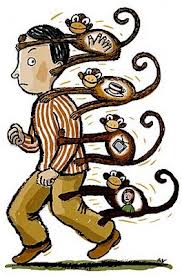What is all this talk about Monkeys you may ask? Well, the article is inspired by one of the most famous management articles written in the Harvard Business Review (HBR) back in 1974 called Management Time – Who’s Got the Monkey?
I think this is a must read for anyone who wants to succeed in their career no matter what your level is today. I actually only read this article 5 years ago and found the examples and advice still very relevant today. In this week’s article, we will talk about tips for managers – why you should leave the Monkeys to your team and focus your time more on Gorillas. Monkeys and Gorillas are basically animated analogies to represent small and large business problems your company is facing.
As the article suggests, if you are not careful as a manager, team members have a way of giving their monkeys (problems they discovered through their work) to you to solve through escalation conversations. Soon enough you will
- Find yourself reporting to your team members about your progress
- Your team members are left with not enough to do and feel less motivated
- You as a manager becomes a bottleneck in solving small issues and
- You left yourself no time to step back and address bigger issues (referred to Steven Covey as Gorillas.)
How can this happen you may ask? Well, here is an excerpt from the article to illustrate how common and easily this can happen to you as a manager.
“Let us imagine a manager is walking down the hall and that he saw one of his subordinates, Jones. Jones greets the manager with ‘Good Morning, By the way, we’ve got a problem. You see…’ As Jones continues, the manager recognize in this problem two characteristics common to all the problems his subordinates gratuitously bring to his attention – the manager 1)knows enough to get involved, but 2) not enough to make the on-the-spot decision expected of him. Eventually, the manager says, ‘so glad you brought this up. I’m in a rush right now. Meanwhile, let me think about it, and I’ll let you know.’ Then he and Jones part company.”
 By the end of this conversation above, the problem or Monkey has jumped from Jones’ back to the manager’s back and the manager has volunteered to take responsibility to do something about it and report back to Jones. Let’s imagine if you have 4 people reporting to you. If all of them had conversations like this with you, you will be covered with “Monkeys” on your back and your team members will all be anxiously waiting for you to tell them what to do next. Does that sound productive?
By the end of this conversation above, the problem or Monkey has jumped from Jones’ back to the manager’s back and the manager has volunteered to take responsibility to do something about it and report back to Jones. Let’s imagine if you have 4 people reporting to you. If all of them had conversations like this with you, you will be covered with “Monkeys” on your back and your team members will all be anxiously waiting for you to tell them what to do next. Does that sound productive?
So to be an effective manager, what should you do instead? Well, the simple answer is – Leave the Monkeys to your team members. Specifically, this means doing all the following instead in the above example:
- Tell Jones what you know – since you as the manager has more information that can help solve the problem, then tell Jones to schedule a meeting with you so you can share what you know.
- Never take ownership of the Monkey – it’s tempting as a manager to just take over and do it yourself since you know more about the issue and are always more experienced than your team. Resist this urge as you are not helping yourself or your team. Just because Jones escalated this issue, does not mean you as the manager need to take it over. Once the Jones does number 1 above and you tell him what you know, suggest where Jones can find out more information and ask Jones to brainstorm recommended solutions and next steps to the problem and get back to you.
- Give feedback and suggestion – After Jones comes back with some recommended solutions, provide your feedback at that time and work together to make progress in the meeting. After Jones receive feedback, he should still leave the meeting with the “Monkey” on his back to go do the next steps that was agreed to solve this issue.
Do you see the difference in how this is addressed? During each interaction between the manager and Jones, the Monkey stays on Jones’ back. You, as the manager, are simply given more support and information so that Jones, the team member, is empowered to solve this problem and further develop his skills. As the manager, because you no longer walk away with the Monkey on your back after every escalation issue, your time is freed to do the work you own and also address “Gorillas” – unexpected large issues you uncover in the work you own or the ones your boss sends your way. This is the only way you can stay effective and demonstrate to your boss that you can take on even bigger responsibilities as they arise.
Your comments: What do you think of this HBR article? Does this example above help you manage better? Add your comments and questions below and let’s have a discussion.
I am always in your corner.
– Lei